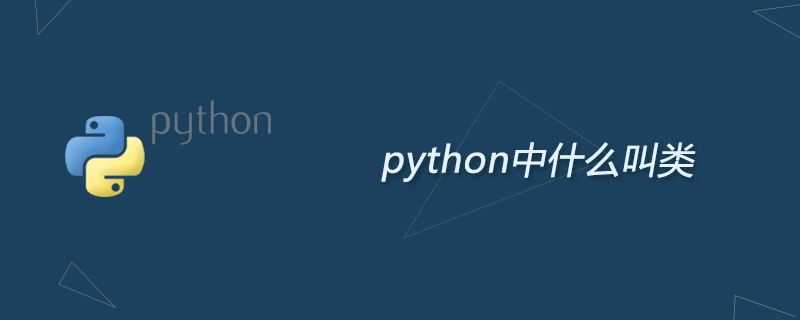python中什麼叫類

python中什麼叫類別?
可以視為種類或類型的同義字。所有的物件都屬於某一個類,稱為類的實例。
例如:鳥就是"鳥類"的實例。這就是一個有很多子類的一般(抽象)類別:看到的鳥可能屬於子類"百靈鳥"。可以將"鳥類"想像成所有鳥的集合,而"百靈鳥類"是其中的一個子集。當一個物件所屬的類是另外一個物件所屬類的子集時,前者就被稱為後者的子類,所以"百靈鳥類"是"鳥類"的子類,"鳥類"是"百靈鳥類"的超類別
定義子類別只是定義更多方法的過程.
#建立類別
>>> class Person: def setName(self,name):
self.name=name def getName(self): return self.name def greet(self): print "Hello,world! I'm %s" % self.name
>>> foo=Person()>>> bar=Person()>>> foo.setName('Nsds')>>> bar.setName('Ysdy')>>> foo.greet()
Hello,world! I'm Nsds>>> bar.greet()
Hello,world! I'm Ysdy在呼叫foo的setName和greet函數時,foo會自動將自己作為第一個參數傳入函數中,因此命名為self。沒有self的話,成員方法就沒辦法存取他們要對其特性進行操作的物件本身了
特性是可以外部存取的:
>>> foo.name'Nsds'>>> bar.name='Yoda'>>> bar.greet() Hello,world! I'm Yoda
特性、函數、方法
self參數事實上正是方法和函數的差別。方法將它們的第一個參數綁定到所屬的實例上,因此這個參數可以不必提供。所以可以將特性綁定到一個普通函數上,這樣就不會有特殊的self參數了:
(特性是物件內部的變量,物件的狀態由它的特性來描述,物件的方法可以改變它的特性,可以直接從物件外部存取特性)
>>> class Class: def method(self): print 'I have a self!'
>>> def function(): print "I don't...">>> s=Class()>>> s.method()
I have a self!>>> s.method=function>>> s.method()
I don't...變數birdsong引用綁定方法bird.sing上,還是對self參數的存取(仍舊綁定到類別的相同實例上)
>>> class Bird:
song='Squaawk'
def sing(self): print self.song
>>> bird=Bird()>>> bird.sing()
Squaawk>>> birdsong=bird.sing>>> birdsong()
Squaawk在名稱前加上雙底線,可以讓方法或特性變成私有(從外部無法存取)
>>> class Secretive: def __inaccessible(self): print "Bet you can't see me..."
def accessible(self): print "The secret message is:"
self.__inaccessible()
>>> s=Secretive()>>> s.__inacessible()
Traceback (most recent call last):
File "<pyshell#182>", line 1, in <module>
s.__inacessible()
AttributeError: 'Secretive' object has no attribute '__inacessible'>>> s.accessible()
The secret message is:
Bet you can't see me...在類別的內部定義中,所有以雙底線開的名字都被"翻譯"成前面加上單底線和類別名稱的形式
>>> Secretive._Secretive__inaccessible<unbound method Secretive.__inaccessible> >>> s._Secretive__inaccessible() Bet you can't see me...
類別的命名空間
定義類別時,所有位於class語句中的程式碼都在特殊的命名空間中執行---類別的命名空間。這個命名空間可由類別內所有成員存取。
類別的定義其實就是執行程式碼區塊
>>> =+=1
>>> m1=>>>>>>1
>>> m1.members=2
>>>2
>>> m2=>>>>>>2
>>>>>>3
>>>2
>>>新members值寫到了m1的特性中,封鎖了類別範圍內的變數
超類別
>>> class Filter: def init(self):
self.blocked=[] def filter(self,sequence): return [x for x in sequence if x not in self.blocked]
>>> class SPAMFilter(Filter): def init(self):
self.blocked=['SPAM']
>>> f=Filter()>>> f.init()>>> f.filter([1,2,3])
[1, 2, 3]>>> s=SPAMFilter()>>> s.init()>>> s.filter(['SPAM','SPAM','egg','name','ff'])
['egg', 'name', 'ff']繼承,超類別
>>> class Filter: def init(self):
self.blockes=[] def filter(self,sequence): return [x for x in sequence if x not in self.blocked]
>>> class S(Filter): def init(self):
self.blocked=['s']
>>> f=Filter()>>> f.init()>>> f.filter([1,2,3])多個超類別
先繼承的類別中的方法會重寫後繼承的類別中的方法
>>> class C(): def calculate(self,expression):
self.value=eval(expression)
>>> class Talker(): def talk(self): print 'Hi,my value is',self.value
>>> class TalkingCalculator(C,Talker): pass>>> tc=TalkingCalculator()>>> tc.calculate('1+2*3')>>> tc.talk()
Hi,my value is 7相關推薦:《Python教程》
以上是python中什麼叫類的詳細內容。更多資訊請關注PHP中文網其他相關文章!

熱AI工具

Undresser.AI Undress
人工智慧驅動的應用程序,用於創建逼真的裸體照片

AI Clothes Remover
用於從照片中去除衣服的線上人工智慧工具。

Undress AI Tool
免費脫衣圖片

Clothoff.io
AI脫衣器

Video Face Swap
使用我們完全免費的人工智慧換臉工具,輕鬆在任何影片中換臉!

熱門文章

熱工具

記事本++7.3.1
好用且免費的程式碼編輯器

SublimeText3漢化版
中文版,非常好用

禪工作室 13.0.1
強大的PHP整合開發環境

Dreamweaver CS6
視覺化網頁開發工具

SublimeText3 Mac版
神級程式碼編輯軟體(SublimeText3)
 PHP和Python:解釋了不同的範例
Apr 18, 2025 am 12:26 AM
PHP和Python:解釋了不同的範例
Apr 18, 2025 am 12:26 AM
PHP主要是過程式編程,但也支持面向對象編程(OOP);Python支持多種範式,包括OOP、函數式和過程式編程。 PHP適合web開發,Python適用於多種應用,如數據分析和機器學習。
 在PHP和Python之間進行選擇:指南
Apr 18, 2025 am 12:24 AM
在PHP和Python之間進行選擇:指南
Apr 18, 2025 am 12:24 AM
PHP適合網頁開發和快速原型開發,Python適用於數據科學和機器學習。 1.PHP用於動態網頁開發,語法簡單,適合快速開發。 2.Python語法簡潔,適用於多領域,庫生態系統強大。
 Python vs. JavaScript:學習曲線和易用性
Apr 16, 2025 am 12:12 AM
Python vs. JavaScript:學習曲線和易用性
Apr 16, 2025 am 12:12 AM
Python更適合初學者,學習曲線平緩,語法簡潔;JavaScript適合前端開發,學習曲線較陡,語法靈活。 1.Python語法直觀,適用於數據科學和後端開發。 2.JavaScript靈活,廣泛用於前端和服務器端編程。
 PHP和Python:深入了解他們的歷史
Apr 18, 2025 am 12:25 AM
PHP和Python:深入了解他們的歷史
Apr 18, 2025 am 12:25 AM
PHP起源於1994年,由RasmusLerdorf開發,最初用於跟踪網站訪問者,逐漸演變為服務器端腳本語言,廣泛應用於網頁開發。 Python由GuidovanRossum於1980年代末開發,1991年首次發布,強調代碼可讀性和簡潔性,適用於科學計算、數據分析等領域。
 vs code 可以在 Windows 8 中運行嗎
Apr 15, 2025 pm 07:24 PM
vs code 可以在 Windows 8 中運行嗎
Apr 15, 2025 pm 07:24 PM
VS Code可以在Windows 8上運行,但體驗可能不佳。首先確保系統已更新到最新補丁,然後下載與系統架構匹配的VS Code安裝包,按照提示安裝。安裝後,注意某些擴展程序可能與Windows 8不兼容,需要尋找替代擴展或在虛擬機中使用更新的Windows系統。安裝必要的擴展,檢查是否正常工作。儘管VS Code在Windows 8上可行,但建議升級到更新的Windows系統以獲得更好的開發體驗和安全保障。
 visual studio code 可以用於 python 嗎
Apr 15, 2025 pm 08:18 PM
visual studio code 可以用於 python 嗎
Apr 15, 2025 pm 08:18 PM
VS Code 可用於編寫 Python,並提供許多功能,使其成為開發 Python 應用程序的理想工具。它允許用戶:安裝 Python 擴展,以獲得代碼補全、語法高亮和調試等功能。使用調試器逐步跟踪代碼,查找和修復錯誤。集成 Git,進行版本控制。使用代碼格式化工具,保持代碼一致性。使用 Linting 工具,提前發現潛在問題。
 notepad 怎麼運行python
Apr 16, 2025 pm 07:33 PM
notepad 怎麼運行python
Apr 16, 2025 pm 07:33 PM
在 Notepad 中運行 Python 代碼需要安裝 Python 可執行文件和 NppExec 插件。安裝 Python 並為其添加 PATH 後,在 NppExec 插件中配置命令為“python”、參數為“{CURRENT_DIRECTORY}{FILE_NAME}”,即可在 Notepad 中通過快捷鍵“F6”運行 Python 代碼。
 vscode 擴展是否是惡意的
Apr 15, 2025 pm 07:57 PM
vscode 擴展是否是惡意的
Apr 15, 2025 pm 07:57 PM
VS Code 擴展存在惡意風險,例如隱藏惡意代碼、利用漏洞、偽裝成合法擴展。識別惡意擴展的方法包括:檢查發布者、閱讀評論、檢查代碼、謹慎安裝。安全措施還包括:安全意識、良好習慣、定期更新和殺毒軟件。






